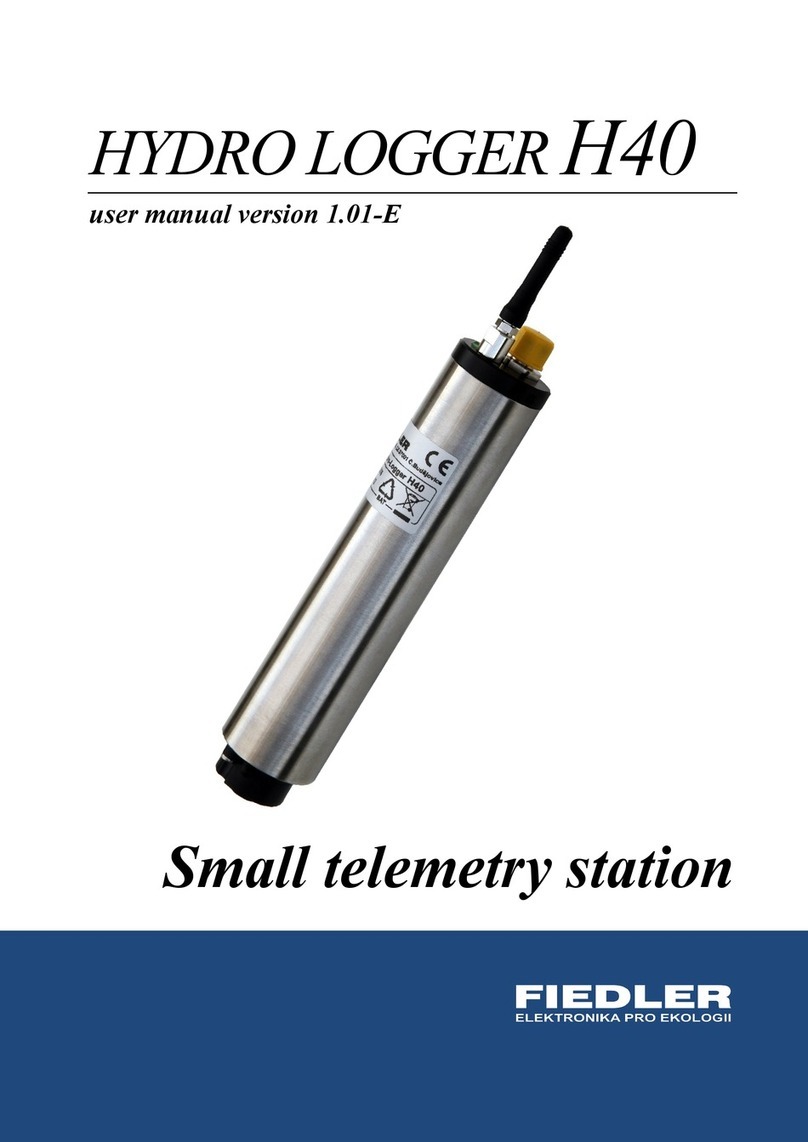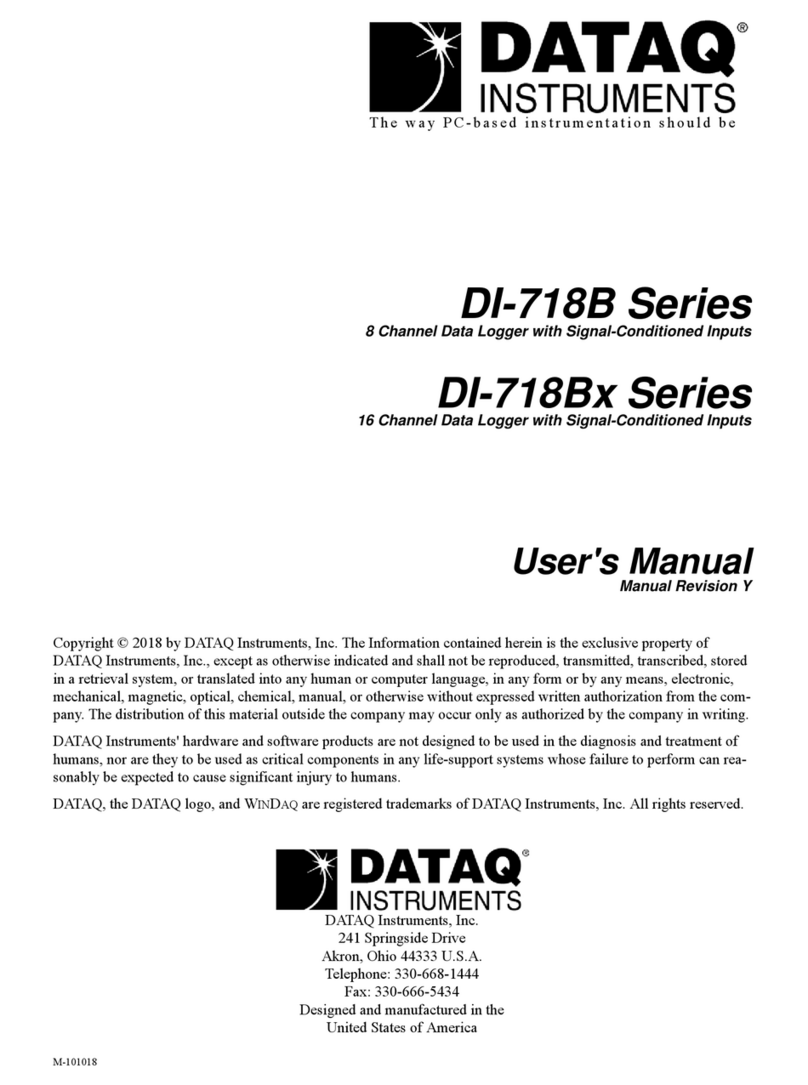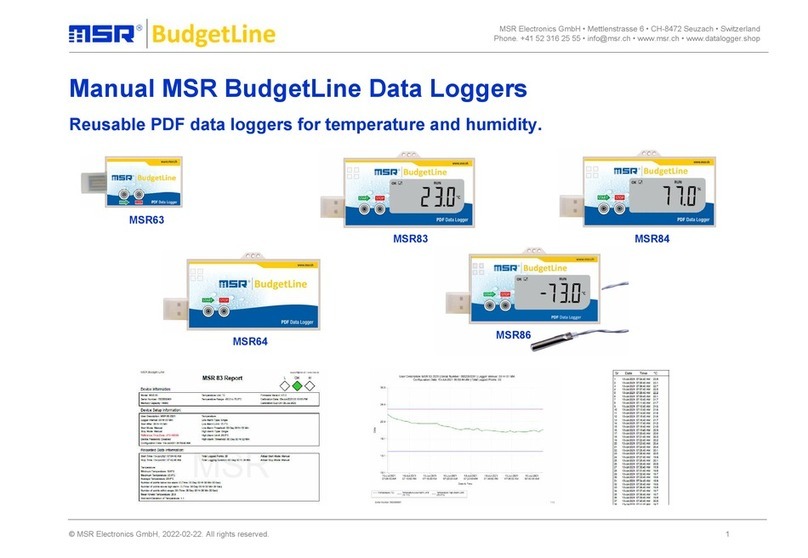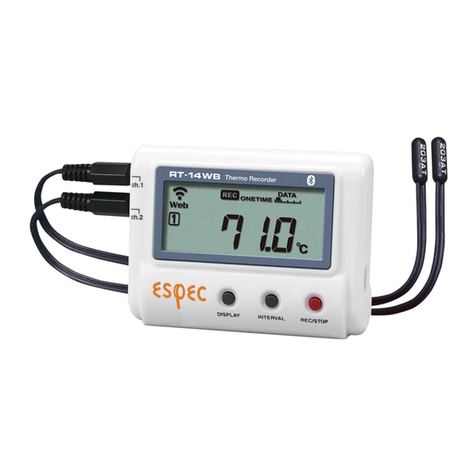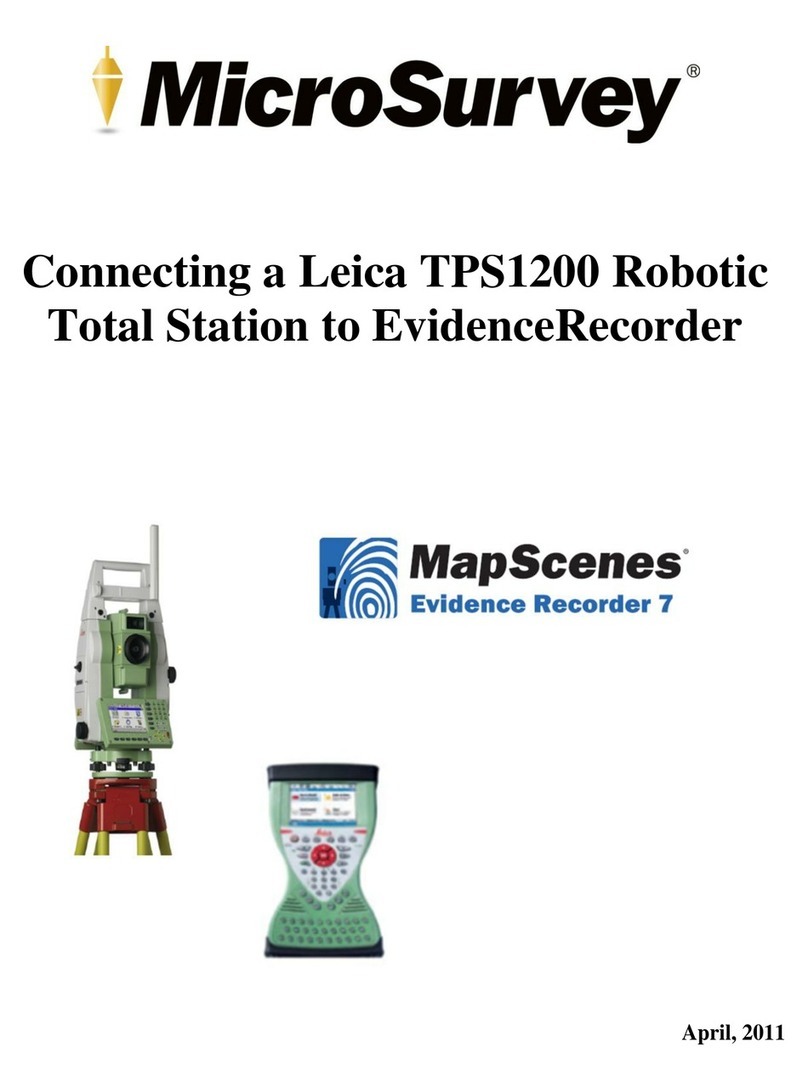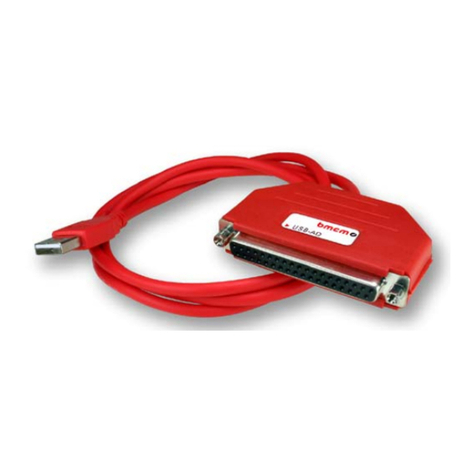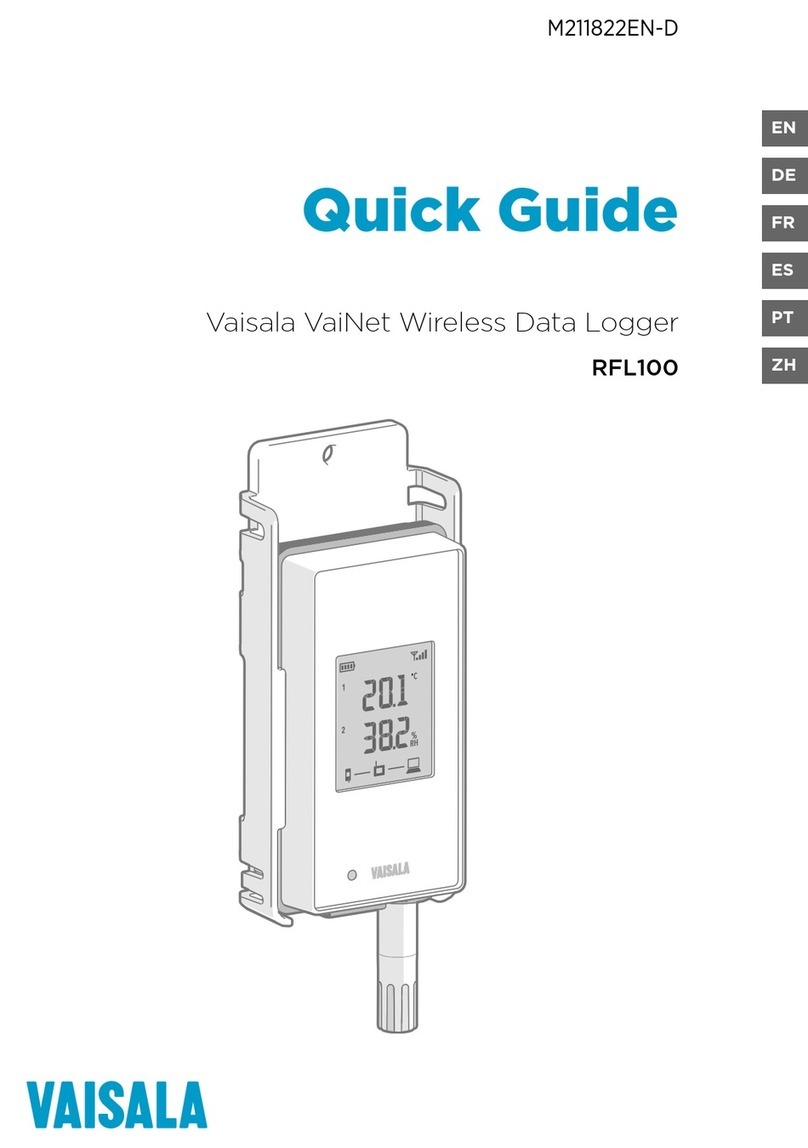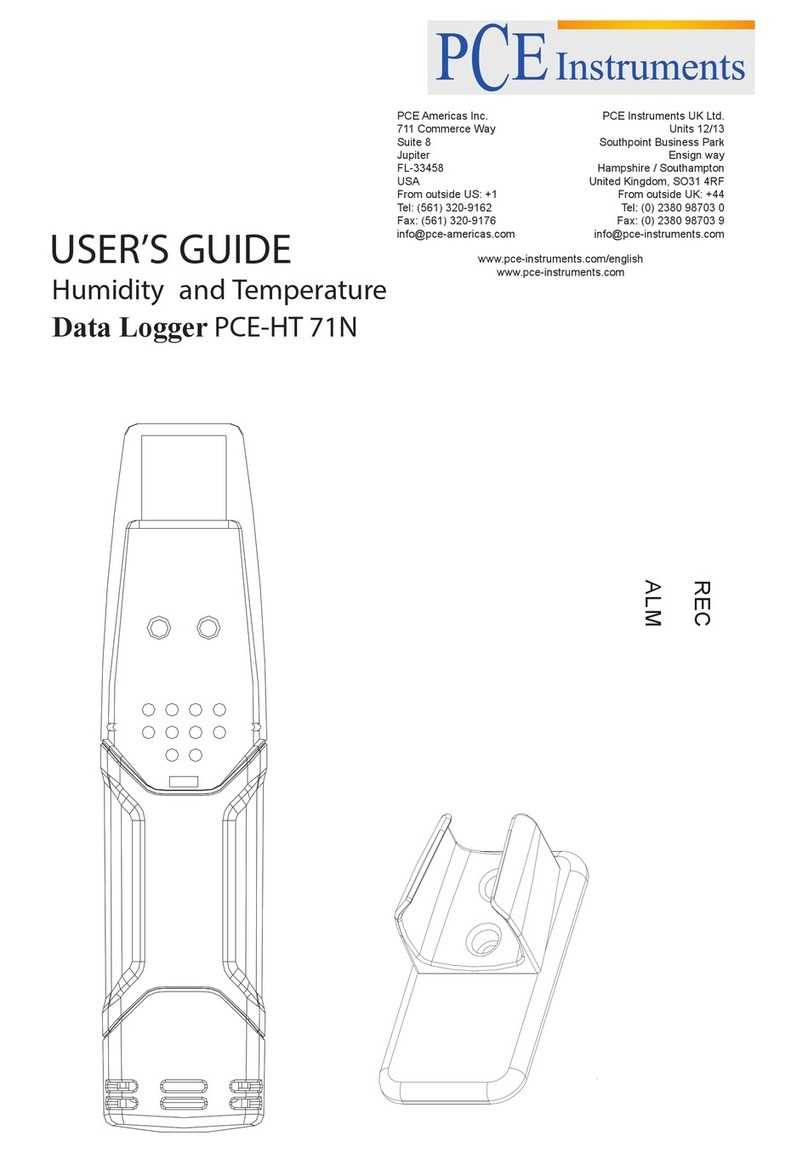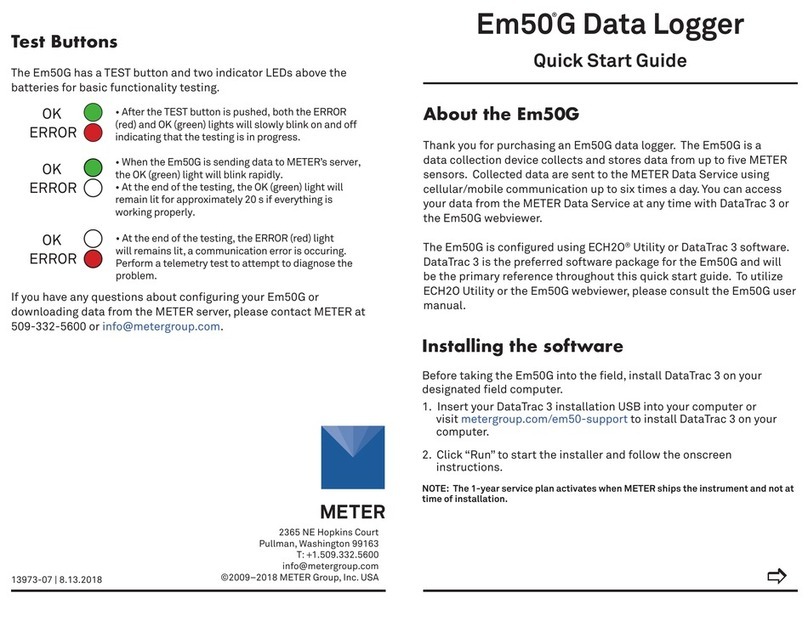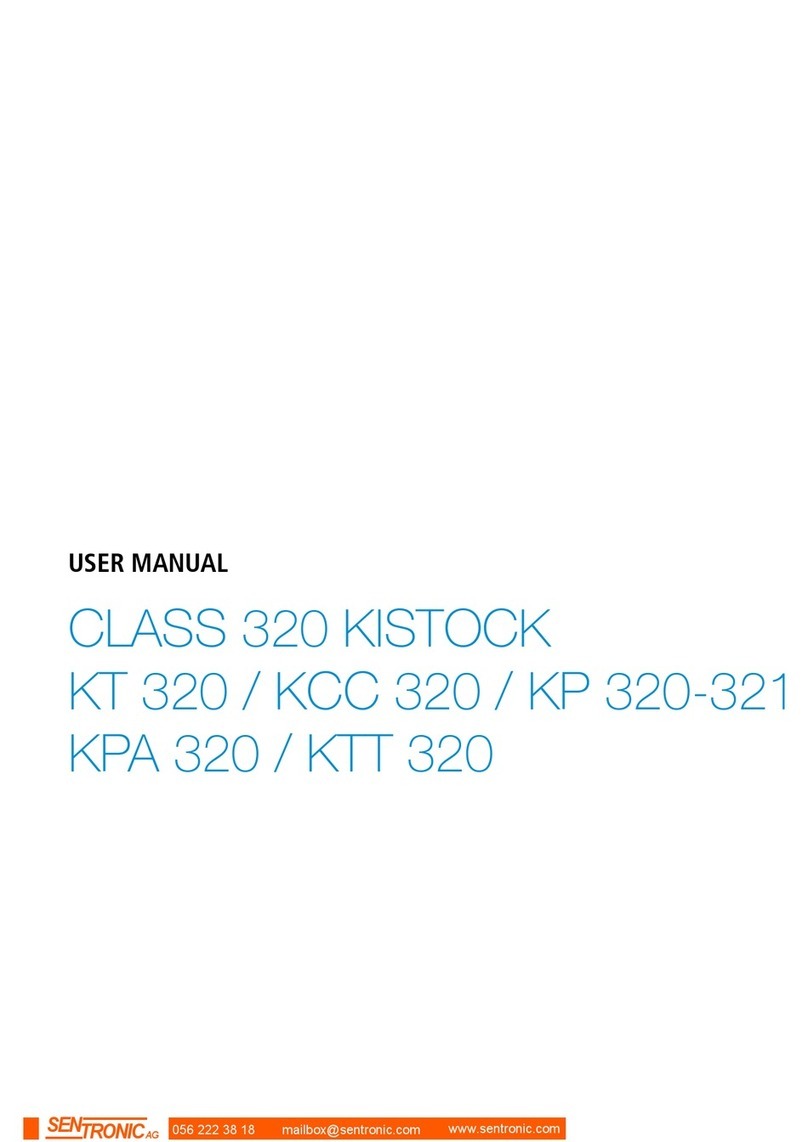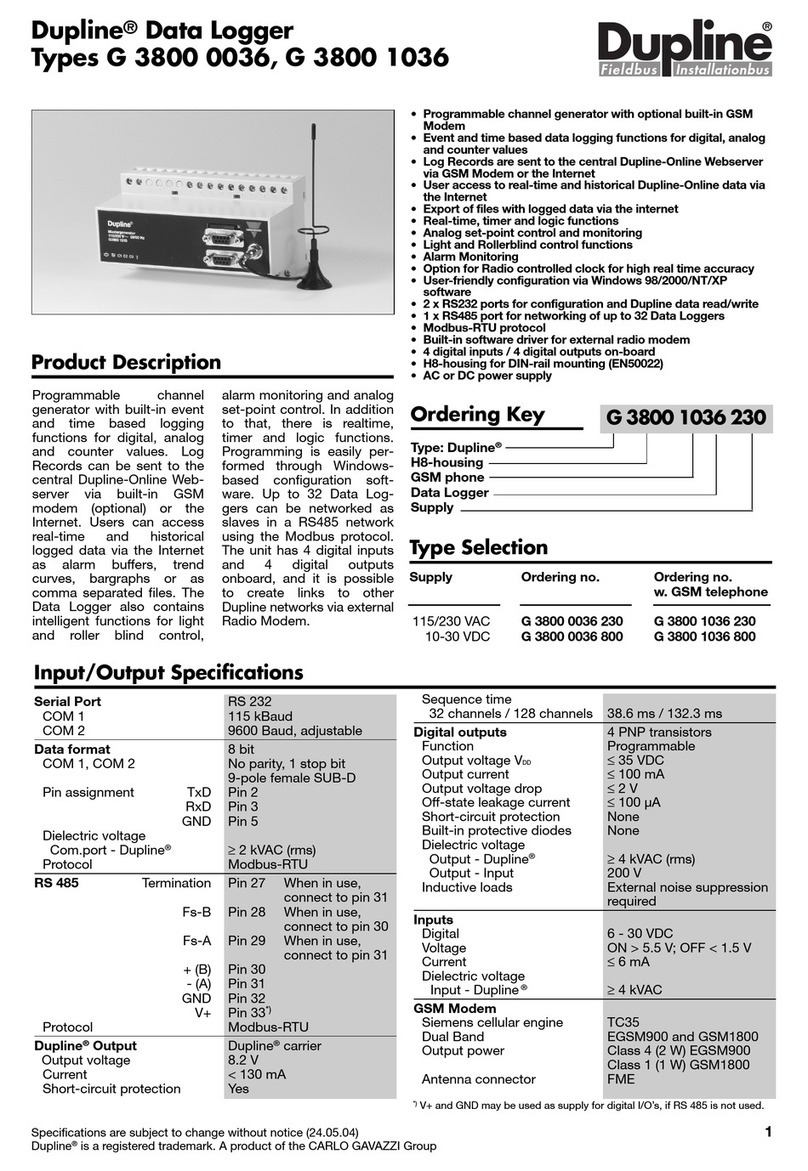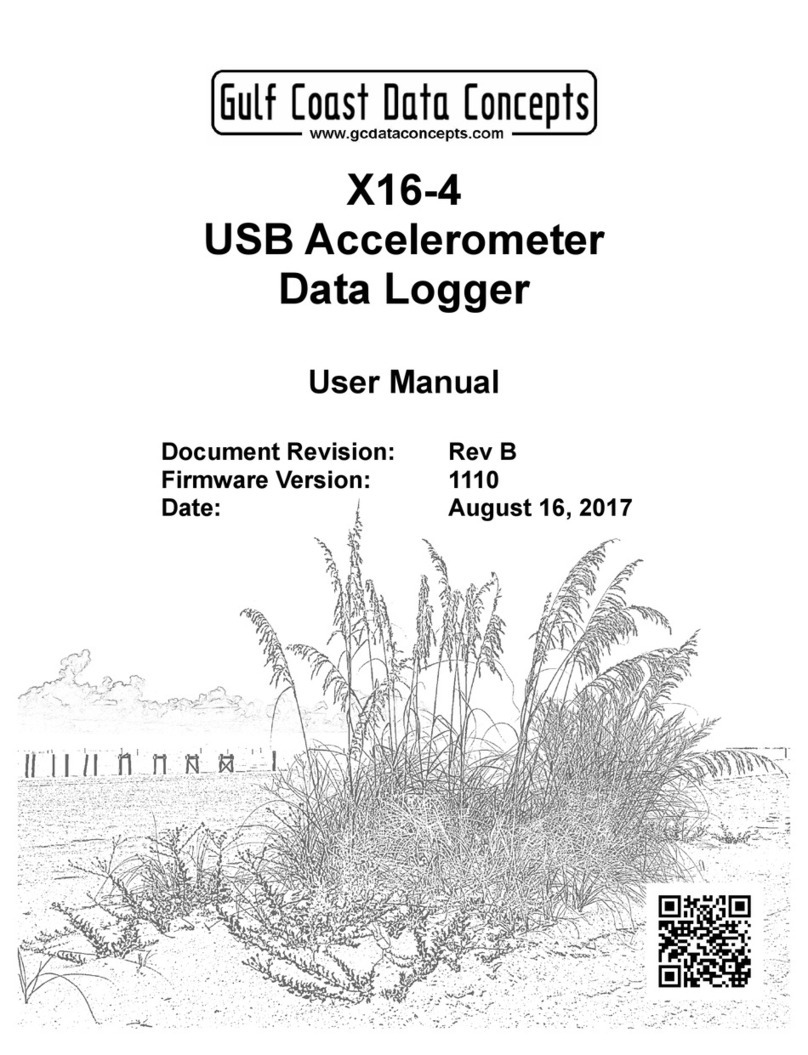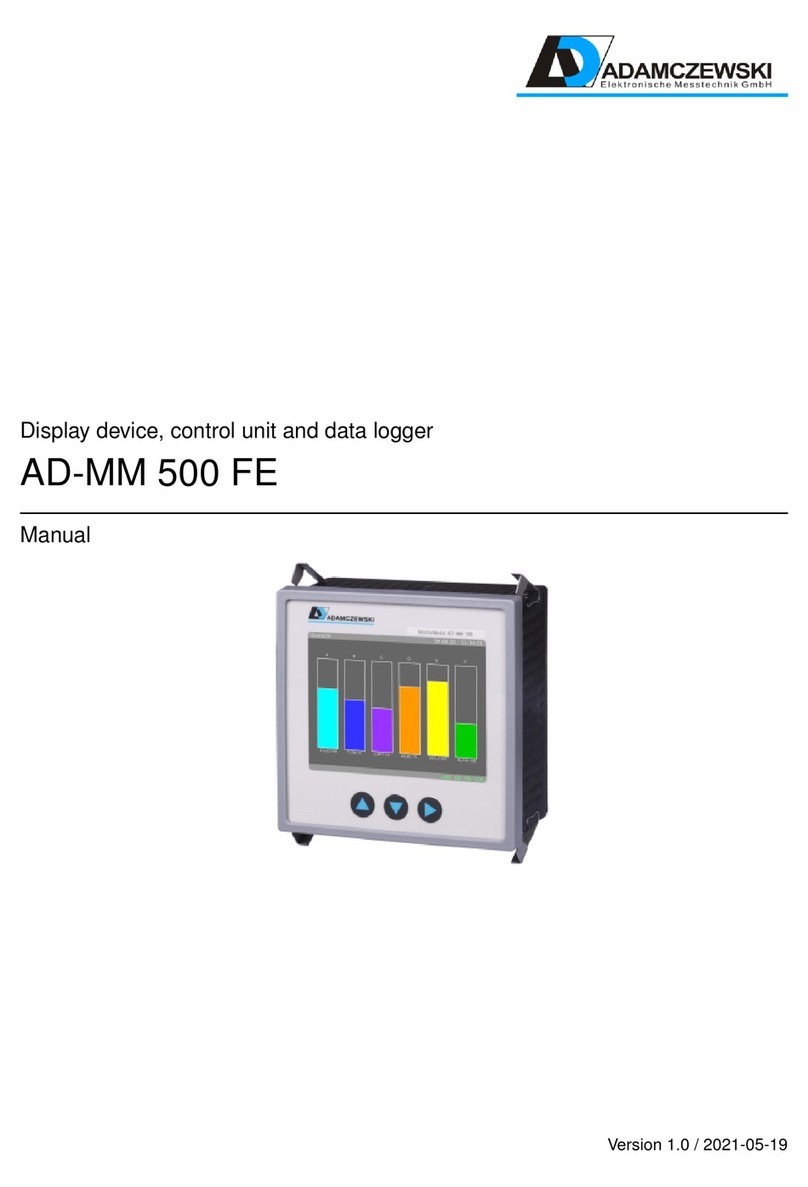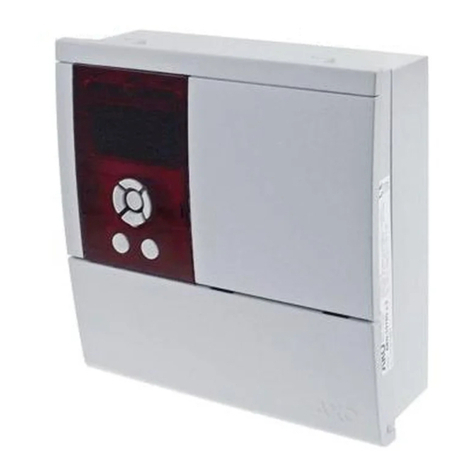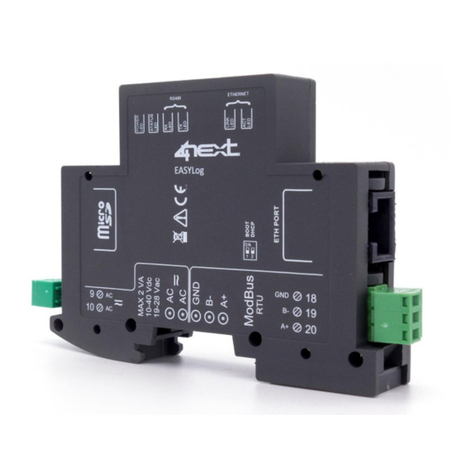FIEDLER H1 User manual

Profiles
Small telemetry station
for water applications
H1, H2 Hydro Logger
user manual version 1.10

Hydro Logger H1
User manual
2
electronics for ecology
FIEDLER

Hydro Logger H1
User manual
FIEDLER electronics for ecology
3
1. SAFETY INSTRUCTIONS 4
2. USING LOGGERS H 1 , H2 5
3. BASIC DESCRIPTION 6
3.1. OVERVIEW OF PROGRAM FUNCTIONS AND PROCEDURES 7
3.2. MECHANICAL DESIGN OF THE INSTRUMENT 9
3.3. COMMUNICATION MODULE 10
3.4. ARCHITECTURE OF AUTOMATIC DATA COLLECTION VIA 11
3.5. COMMUNICATION WITH THE DEVICE 14
3.6. POWER SUPPLY SYSTEM 15
4. INSTALLATION 17
4.1. MECHANICAL PLACEMENT OF THE DEVICE 17
4.2. INSERT YOUR OWN SIM CARD 24
4.3. ANTENNA AND ITS LOCATION 25
4.4. CONNECTING SENSORS AND TRANSDUCERS 28
5. BASIC CONTROL OF THE DEVICE 37
5.1. CYCLIC DISPLAY OF MEASURED VALUES 37
5.2. SWITCHING ON THE INTERNAL GSM/GPRS MODULE 39
5.3. EXTRAORDINARY DATA UPLOAD TO THE SERVER 41
6. PARAMETER SETTINGS 42
6.1. MOST PROGRAMME 42
6.2. BASIC PARAMETERS 43
6.3. ANALOG CHANNEL SETTINGS 48
6.4. CONTROL CHANNELS 60
6.5. BINARY CHANNEL SETTINGS 61
6.6. GSM PARAMETERS 62
6.7. SMS COMMUNICATION 63
6.8. SMS DISTRIBUTION 63
6.9. WARNING AND CONTROL SMS 68
6.10. PARAMETERS FOR SENDING DATA UNDER TCP/IP PROTOCOL 75
7. SERVICE AND MAINTENANCE 76
7.1. FIRMWARE UPDATES E 76
7.2. PROCEDURE FOR REPLACING THE POWER SUPPLY BATTERY 77
8. TECHNICAL PARAMETERS 78

Hydro Logger H1
User manual
4
electronics for ecology
FIEDLER
1. Safety instructions
•The installation of the device with external power supply must be carried
out by a person with the necessary qualifications for the installation of
electrical equipment. The installer must carry out the installation in accor-
dance with all instructions, regulations and standards relating to safety and
electromagnetic compatibility.
•If the safety or health of persons or serious damage to property could be
endangered as a result of a malfunction of the equipment, independent me-
asures must be taken or equipment must be installed to eliminate this risk.
•All connected downstream equipment must comply with the relevant stan-
dards and safety regulations and be equipped with suitable anti-interfe-
rence filters and surge protection.
•Do not use in explosion hazardous areas!
•Do not use in areas of excessive vibration.
•The manufacturer is not liable for damages resulting from improper installa-
tion, improper maintenance or use contrary to the recommendations in the
operating instructions.
!
If used, the external power supply must meet all safety standards and be
appropriate for the environment in which it will be operated.
!
When installing a submersible level sensor, make sure that even at the ma-
ximum possible water level, the permissible measuring range of the sensor
is not exceeded.
1

Hydro Logger H1
User manual
FIEDLER electronics for ecology
5
2. Using Loggers H 1 , H2
The Hydro Logger H1 is primarily designed for data collection in the water in-
dustry. This requirement is met by a robust mechanical design with high IP67
protection, its own battery power supply rated for several years of operation,
up to 4 pulse inputs for connecting OPTO and REED sensors from water meters,
two current inputs for connecting pressure and level sensors, universal RS-485
serial interface for connecting probes and sensors under FINET or Modbus pro-
tocol.
Level Logger H2 is a variant suitable for the construction of local warning sys-
tems based on continuous monitoring of river, stream and reservoir levels as
well as rainfall, where, unlike Hydro Logger H1, it allows the connection and
calculation of rainfall using dynamically calibrated rain gauges.
The common features of both devices include their own data connectivity via a
built-in GSM/GPRS module and software support on the server allows the Hydro
Loggers H1 to form large-scale monitoring networks independent of external
power supply.
TYPICAL EXAMPLES OF USE
▪Monitoring of smaller technological equipment (WWTP, DHW, ...)
▪Basic element of a monitoring network for monitoring flows, pres-
sures or levels via GSM/GPRS network
▪Warning system alerting by sending an alarm SMS when limit values
are exceeded.
▪Replacement of missing or damaged cabling in CS-VDJ systems
▪Remote reading of water meters.
▪Measurement and data acquisition in the gas and energy sector
▪Environmental monitoring
▪Measurement of levels and flows in sewer networks
▪Measurement of levels and flows in open river profiles
▪Small weather stations with remote data transmission
▪Universal measuring unit for scientific and research institutes
2

Hydro Logger H1
User manual
6
electronics for ecology
FIEDLER
3. Basic description
Both types of Loggers H1 and H2 are modern designed devices with very low
current consumption. The applied manufacturing technology, careful selection
of components with regard to a wide range of operating temperatures, high de-
gree of protection of the electronic part of the device against condensing mois-
ture and mechanical damage, guarantee high reliability of the device even in
extreme operating conditions.
In the following, the description of the Hydro Logger H1 will also apply to the
Level Logger H2.
The display cyclically shows the measured values, the status of the power bat-
tery, the number of data sessions, etc. The display can also show, for example,
the current GSM signal strength at the location of the GSM antenna when it is
installed, humidity and temperature inside the device, selected statistical va-
lues, etc. In order to save the capacity of the power supply battery, the display
and its backlight are switched off in normal mode and activated for a certain
period of time by pressing a button.
The logger allows you to set up to 8 recording channels K1-K8 for measuring
selected physical quantities and 8 binary channels B1-B8 for recording states on
binary inputs.
In addition to the recording and binary channels, the Logger also includes 7 K9-
K15 control channels for recording the battery voltage magnitude, the remai-
ning battery capacity expressed as a %, the current drawn by the connected
sensors during measurement, and the temperature and humidity inside the in-
strument.
The capacity of the data memory is sufficient for several years of data recording
in normal operation. When the memory is full, the oldest stored values are gra-
dually overwritten. The data memory also records extraordinary events - receipt
or sending of SMS, occurrence of an input error, data transfer to the server, etc.
The logger operates in a power saving mode in which the instrument is hiberna-
ted most of the time and only wakes up and takes measurements at the set
archiving interval. During the measurement period, power is supplied to the
3
G r a p h i c d i s p l a y
R e c o r d i n g
c h a n n e l s
C o n t r o l c h a n n e l s
D a t a m e m o r y
E c o n o m i c a l
o p e r a t i n g m o d e

Hydro Logger H1
User manual
FIEDLER electronics for ecology
7
connected sensors and transducers. The magnitude of the supply voltage is ad-
justable in the range of 6-17 V DC.
Logger - The telemetry station transmits the measured values via GSM/GPRS
communication to a database on the server. In addition, the station can send
warning or informative SMS and receive query or control SMS. Via GSM/GPRS
data communication it is also possible to change parameter settings and per-
form FW upgrades.
Setting of all H1 station parameters is done via MOST. Parameters can be chan-
ged from a PC (laptop) via cable connection or remotely via web browser and
data server.
For the power supply of the instrument is used 1 lithium battery size D, which
allows many years of operation of the instrument even with daily transmission
of measured data to the server via GSM/GPRS network. When the battery is
depleted, indicated by the remaining capacity on the K13 control channel drop-
ping to zero, the user can replace the battery himself.
An external power source (battery or 12V DC power supply) can be connected
to the instrument and the internal battery can only be used as a backup power
source in case of external power failure.
3.1. Overview of program functions and procedures
The following overview briefly summarizes the program procedures and functi-
ons contained in the H1 station FW, which are fully available to the station users
during its parameterization and setup. Most of these functions will be described
in detail in the "Setup" chapter.
▪Calculation of instantaneous and cumulative flow from pulses from REED
and OPTO sensors.
▪Calculation and storage of the measured quantity in set units of measure-
ment.
▪Sliding sum over a configurable time interval over a selected channel (flow
or rainfall) to activate an SMS alarm message.
▪Calculation of instantaneous flow rate and leakage volume for commonly
used gauge troughs and gauge overflows (Parshall or Venturi troughs, Tho-
mson overflow, ...). In the H2 instrument, 14 equations for frequently used
profiles are preset.
▪Flow calculation for composite Parshall troughs (double and triple combina-
tions).
▪Calculation of the flow rate from the tabulated level/flow relationship.
▪Calculation of rainfall and precipitation totals using pulse weighting, but also
using a dynamically calibrated rain gauge table (H2 only)
▪Sum and difference functions over two channels (sum and difference of me-
asured quantities). Calculation of moving average and trend over any chan-
nel.
▪The nonlinear output signals can be corrected by a 2nd order polynomial
separately for each of the set channels.
G S M
c o m m u n i c a t i o n
P a r a m e t e r
s e t t i n g s
B a t t e r y p ow e r
s u p p l y
E x t e r n a l p owe r
s u p p l y
C a l c u l a t i o n s

Hydro Logger H1
User manual
8
electronics for ecology
FIEDLER
▪For channels recording flow or rainfall, both daily and monthly total flow is
calculated.
▪Motor hours with resolution to minutes for each binary channel.
▪Separate limit alarm for each recording channel.
▪Separate gradient alarm for each recording channel.
▪For the duration of an alarm on a channel, you can set a different frequency
of data being written to memory than in normal operation and a different
frequency of data being sent to the server.
▪Data transmissions are performed under FINET or Modbus RTU protocols.
Data packet transmissions via GSM/GPRS are performed under TCP/IP pro-
tocol.
▪Regular sending of archived values via GPRS network to the Internet to the
set IP address (to the server with installed MOSTNET-SERVER program).
▪Phonebook for 10 recipients, up to 3 groups possible.
▪Alert system based on 14 user configurable and 8 predefined SMS messages.
▪Activation of sending SMS or transferring data to the server via GPRS
network periodically in time or after reaching the limit value on the measu-
ring channel, after activation of limit or gradient alarm, in case of sensor
fault, low battery voltage, after activation of binary input or on request by
query SMS.
▪Configurable delay and hysteresis for limit SMS.
▪25 query and command codes to build a query or control SMS.
▪Automatic insertion of the instantaneous value of the measuring channel
into the SMS text.
▪Program-controlled switching on of the modem for a specified time interval
of hours to weeks.
▪Set the time for sending daily SMS and the time and day for weekly SMS.
▪Automatic switching between winter and summer time ensures regularity in
sending SMS. Automatic archiving of the current parameter file on the ser-
ver after each parameter change.
▪The event log contained in the data memory records extraordinary events
(switching on of selected inputs, power failure and power restoration, inco-
ming and outgoing SMS, occurrence of an error signal at connected sensors,
successful and unsuccessful data transfer to the server, etc.).
S t a t i s t i c a l
c al c ul a t i on s
A l a r m s
C o mm un i c ati on
O p e r a t i o n a l dia ry

Hydro Logger H1
User manual
FIEDLER electronics for ecology
9
3.2. Mechanical design of the instrument
The electronic part of the Hydro Logger H1 is housed in a 160 mm x 90 mm x 60
mm metal casting, which consists of two parts. Between the two parts there is
a silicone sealing profile. The screws that connect the two parts are located on
the sides of the box under the plastic caps.
The lower part of the casting contains cable glands, a replaceable power battery
inserted in a plastic holder and a PCB connection board with connection termi-
nals and surge protectors.
The upper part of the box carries the main PCB of the device with graphic dis-
play, button and connectors for PC and GSM antenna connection. The configu-
ration switch and SIM card holder are accessible from the bottom of the lid.
There is a flat cable between the two parts. This design allows the upper top
part to be disconnected from the connection plate during installation, making it
easier to connect the cables from the sensors to the terminal block.
The high IP67-rated metal box protects the electronic circuits from external in-
terference as well as from adverse climatic conditions and is highly resistant to
mechanical damage.
As standard, the Hydro Logger H1 is equipped with 3 M12 cable glands for cables
with a diameter of 3 to 6 mm and one M16 cable gland for cables with a diame-
ter of 4 to 8 mm.
The Hydro Logger H1 can be supplied with the DH1 mounting bracket, which is
used for mounting the device on the wall. The bracket also includes 4 stainless
steel screws and a set of dowels and screws.
M e t a l b o x
C a b l e g l a n d s
M o u n t i n g b r a c k e t

Hydro Logger H1
User manual
10
electronics for ecology
FIEDLER
3.3. Communication module
Using an internal communication module, the hydro Loggr H1 connects to a ser-
ver on the Internet. The module is integrated into the device during the manu-
facturing and initial configuration of the device.
GSM/GPRS TECHNOLOGY
The communication module of the Hydro Logger H1
uses GSM/GPRS technology. It is a universally appli-
cable technology with excellent local and global
coverage, offering low operating costs and accepta-
ble battery life even for devices not connected to an
external power supply.
The communication module mediates all data
transmissions between the station and the user. It is
therefore usually not necessary to connect to the sta-
tion from a PC (laptop).
Measured data stored in the station is automatically
transferred via GPRS network to the database on the
server at the specified time. Conversely, a parameter
file is transferred from the server to the station if any
changes to the station parameters are needed. The
parameter file is transferred at the end of the data session and only if the user
has changed at least one of the parameters and placed the new parameter file
on the server. The MOST program is used to manage the parameter file.
The system of active stations and a passive server allows the GSM module to be
permanently switched off and only switched on when the station requests to
transfer measured data to the server or to send a warning SMS.
This concept allows the station to operate for many years without changing the
power battery. In a practical test, it was tested that the H1 station is able to
make up to 2,800 data sessions to the server (or send the same number of SMS
alerts) without changing the battery.
The GSM/GPRS communication module enables two-way data communication
including GPRS transmissions and sending or receiving SMS.
SIM CARD
The GSM/GPRS communication module can work with all types of prepaid and
tariff SIM cards, including SIM deployment in roaming traffic, i.e. abroad.
The amount of data transferred depends on the frequency of data sessions from
the device to the server. Typical monthly data consumption is in units of MB.
The device can be operated abroad using the local SIM card of the country in
question. Then it is typically necessary to set up the unit according to the requi-
rements of the local/domestic operator (APN parameters) or it is possible to use
a SIM card of the Hydro Logger manufacturer with permanently allowed opera-
tion in another country, i.e. roaming. When operating the unit while roaming,
higher operating costs for the SIM and application of the regulations of the
country in question can be expected.
Vo l u m e of
t r a n s m i t t e d d at a
F o r e i g n S I M
t r a f f i c

Hydro Logger H1
User manual
FIEDLER electronics for ecology
11
3.4. Architecture of automatic data collection via
The H1 telemetry station is equipped with a GSM/GPRS data module for auto-
matic transfer of measured data from the device to the database on the server.
ACTIVE STATIONS SYSTEM
FIEDLER telemetry stations are characterized by long battery life and very low
operating costs with regular data transmission to the server. This has been
achieved by a system of active stations and a passive server:
▪The server is always on and waiting for data from the individual teleme-
try stations, which themselves determine when the data will be
transmitted to the server.
▪The system can receive data from multiple stations simultaneously.
▪The GSM/GPRS modem in the station is switched on only for the ne-
cessary time needed to transfer data from the station to the server -
saving power of the power battery.
▪If an extraordinary event occurs at the measurement location, the sta-
tion can immediately transmit this information to the server - the usual
delay of cyclical calling of stations by the server is eliminated.
▪The system allows the use of operationally cheap types of tariff SIM
cards without a fixed IP address in the stations. The fixed IP address is
usually charged for and this increases the overall operating costs of the
system.

Hydro Logger H1
User manual
12
electronics for ecology
FIEDLER
DATA SERVER SERVICES
The data server is accessible via a standard web browser. After logging in, the
user can use the services of the data server, which include:
▪generation of graphs and tables of measured values
▪exports measured values for the selected period to the user's PC
▪automatic forwarding of received data from the station to another ftp
server
▪printing of graphs and monthly reports including statistical summaries
▪creating virtual stations that can contain differently averaged, summed
or otherwise adjusted data from different real stations in one graph
▪automatic sending of e-mails to preset addresses after meeting the set
conditions (exceeding or dropping of the measured value over the set
limits, switching on/off of the binary channel, error conditions, ...).
SIM CARD RENTAL
The owner of the telemetry station can use any SIM card for data transmissions,
which will be enabled for GPRS data transmissions and SMS messages. The data
server operator also offers long-term loan of its own SIM cards together with
the delivery of the station. These borrowed SIM cards have a low monthly fee
and this includes 1 MB of free data/month. 1 MB of data is sufficient for the
normal operation of the station in the vast majority of cases.

Hydro Logger H1
User manual
FIEDLER electronics for ecology
13
PARMATRIZATION OF THE STATION REMOTELY
A special server service allows you to change the settings of the station parame-
ters remotely over the Internet and GSM/GPRS network via the MOST program.
All previous and current parameter files are stored in the server database, inc-
luding the date and time of their change and the login name of the specific user
who made the parameter change.
DATAHOSTING SUMMARY SERVICE
All of the above services are available to station users for a low annual fee, which
is incomparable to the investment in the equipment of your own server and its
regular maintenance. This makes the data collection system accessible to users
of one or two telemetry stations as well as to operators of a large monitoring
network.
MAP VISUALIZATION
In some applications, it may be advantageous to display the location of the sta-
tion and its current sta-
tus on a map base. The
status can be both in-
formation about the
station's trouble-free
operation and the mea-
sured values of the se-
lected channel.
An example is the freely
accessible server
www.hladiny.cz, which
displays measured data
from hundreds of stati-
ons installed on rivers
and streams across the country.
Incorporation of the station into the system is performed by the server adminis-
trator at the request of its owner.

Hydro Logger H1
User manual
14
electronics for ecology
FIEDLER
3.5. Communication with the device
Parameter setting and transmission of measured data can be done either remo-
tely via the server and GSM/GPRS network as mentioned in the previous chap-
ter, or locally via cable from a connected PC (laptop)
The local connection of the Hydro Logger H1 to a PC or laptop can be made using
the KP232/M8 communication cable.
On the PC side, the cable is connected via
a nine pin connector to the RS232 port. If
the PC or notebook is not equipped with
an RS232 connector, it is necessary to add
a USB/RS232 converter (a suitable type of
converter can be ordered together with
the communication cable from the device
manufacturer).
On the side of the H1 unit, the M8 con-
nector is located in the lower right corner
of the unit for cable communication.
After connecting the HydroLogger H1 to a
PC (notebook), the MOST program can be
used to perform a complete setup of the
instrument parameters, reading archived
data from the instrument memory and
saving them to a file, as well as visualizing
the actual measured values from the con-
nected sensors and transducers.
A certain limitation for the communica-
tion between the PC and Hydro Logger H1
is the fact that this communication cannot
be established while the GSM module is
switched on in Hydro Logger H1. Howe-
ver, since the GSM module is rarely swit-
ched on when sending measured data to
the server, this limitation does not play a
significant role when setting parameters.
Connecting the pins of the M8 communi-
cation connector:
The USB/RS232 converter is used to convert
signals between USB and RS232 interface for
newer types of PCs and laptops without
RS232 serial port
C a b l e c o n n e c t i o n
R S 2 3 2 i n t e r f ac e
M O S T p r o g r a m m e
R e s t r i c t i o n s on
c o m m u n i c a t i o n
Com m u n i c a t i o n
c a b l e K P 2 3 2/M8
PIN
1
2
3
Signal
TxD
GND
RxD
U S B / R S 2 3 2
c o n v e r te r

Hydro Logger H1
User manual
FIEDLER electronics for ecology
15
3.6. Power supply system
3.6.1. Battery power supply
The HydroLogger H1 is supplied with an embedded 3.6V/13Ah lithium battery.
Because the operating time of the device is extremely long when the parame-
ters are set correctly, there is no need to change the battery for the first few
years of operation.
The remaining capacity of the power battery is displayed in the left part of the
graphic display in the form of a bar graph for quick operator orientation. The
bar graph is displayed at the beginning of the display cycle after the 1st press of
the PRESS button.
At full battery capacity, 4 bargraph ticks are displayed above the battery mark.
If this capacity drops below 25%, it is advisable to replace the battery.
A further reduction of the capacity to 10% causes the instrument to enter hiber-
nation mode, in which automatic GPRS transfers of measured data to the server
and SMS sending are disabled and only the datalogger function with measure-
ment and archiving of data from connected sensors and sensors remains active
in the instrument. In hibernation mode, a low battery warning appears on the
display every time the instrument wakes up by pressing a button.
If the user has activated a warning SMS in the device parameters when the ba-
ttery capacity drops, a warning SMS will also be sent to the same phone number
notifying the user of the transition to the Hybernation mode. At the same time,
this information is also stored in the database on the server with the last data
transfer, so that the authorized client is also informed about the low battery
capacity in the device (assuming that the data can be transmitted to the server
when the battery voltage is low).
3.6.2. External power supply
The external power supply can be a mains power supply with an output voltage
of 8 to 15 VDC or a solar panel supplemented with a rechargeable maintenance-
free 12 V battery and a rechargeable RS13 charge controller. The H1 station has
a very low idle power consumption from the external power supply and there-
fore two 12 V batteries can be used for external power supply and these can be
changed and recharged regularly.
B a r g r a p h o n
d i s p l a y
H y b e r n a t i o n m o d e
N o t i f i c a t i o n of
t r a n s i t i o n t o
h i b e r n a ti on

Hydro Logger H1
User manual
16
electronics for ecology
FIEDLER
The external power supply of the H1 station is particularlysuitable for use in cases
where the sensor connected to the station has a high current consumption or
where data transmissions to the server are to be made more frequently than once
a day or in cases where warning or informative SMS are sent frequently.
The internal lithium battery is automatically disconnected when external power is
applied and serves only as a backup power source in case of external power failure.
3.6.3. Connecting H1 to an external power supply
The external power supply can consist of a mains power supply or a solar panel
assembly, a maintenance-free battery of suitable voltage and capacity (usually
12V/9Ah) and an RS13 charge controller to prevent overcharging the battery.
The battery should be supplemented by the power supply itself, which must
then have a suitable output voltage (13.75 V DC).
The external supply voltage is
connected toterminals 1 (+Uext)
and 2 (GND). The maximum size
of the external power supply is
15 V DC. Higher voltages can
cause damage to the protection
circuits and to the Hydro Logger
H1's own DC/DC converter. The
external voltage magnitude is
periodically measured and sto-
red in control channel K9.
The high efficiency of around 90% and the virtually zero self-consumption of the
internal inverter do not burden the external power supply with a continuous con-
sumption, but only when the Hydro Logger wakes up from sleep. Between mea-
surements, the Hydro Logger H1 is put to sleep and only the inverter's quiescent
current,which is on the order of tens of µA andless thanthe battery'sself-discharge
current, is drawn from the external power supply (usually a 12 V battery).
CONNECTING H1 TO THE SOLAR PANEL
The photovoltaic solar panel has an output voltage of up to 17 V. Therefore, it
is connected to the battery via a limiting charging regulator RS13, which on the
one hand switches off the charging of the battery after its full charge and on the
other hand ensures disconnection of the battery from the load in case the bat-
tery voltage drops below 11 volts and thus prolongs the life of the used battery.
C l a m p s f o r
c o n n e c t i n g
e x t e r n a l p o w e r
s u p p l y
L ow i d l e p o w e r
c o n s u m p t i o n f r o m
a n e x t e r n a l
s o u r c e

Hydro Logger H1
User manual
FIEDLER electronics for ecology
17
4. Installation
The installation of the Hydro Logger H1 and the entire telemetry system can be
divided into:
•Mechanical placement of the instrument including sensor and
transducer connections
•To insert an unblocked SIM card
•Finding the optimal GSM antenna location
•Setting instrument parameters
The detailed description and setting of individual parameters is covered in Cha-
pter 5.
4.1. Mechanical placement of the device
If possible, then install the Hydro Logger in a location free of persistent conden-
sing moisture. If this cannot be avoided, then use one of the protective enclo-
sures described below for installation, or take extra care to tighten the cable
glands with the cables passing through and to tighten the two parts of the metal
enclosure that make up the housing of the H1. Before closing the enclosure,
check that the silicone sealant profile of the lid is not dirty and, if necessary,
lubricate it with silicone petroleum jelly to improve the sealing properties.
The Hydro Logger H1 should not be installed in areas where the temperature
consistently exceeds 30 °C, as this increases the self-discharge of the power ba-
ttery and shortens its life. On the other hand, low temperatures below -10 °C
reduce the capacity of the battery and this again results in a shorter overall ope-
rating time. The optimum location for the communicator in terms of battery life
is ventilated underground spaces and similar cooler locations.
The device should also not be installed in areas of direct sunlight, which can
adversely affect the life of the device's front plastic label and also reduce the
readability of the LCD display. Radiation can cause the front panel to become
brittle over time, so when installing the instrument outdoors, it is advisable to
cover it with a suitably sized shade cover or use one of the available cover enc-
losures.
4
Te m p e r a t u r e
i n f l u e n ce s
P r o t e c t i o n f r o m
d i r e c t s u n l i gh t

Hydro Logger H1
User manual
18
electronics for ecology
FIEDLER
4.1.1. Mounting bracket DH1
The Hydro Logger H1's simple stainless
steel bracket has two mounting holes for
quick attachment to the support
structure. The bracket also includes a set
of mounting screws and dowels.
The DH1 bracket is simply attached to
the wall using two dowels and the
supplied screws and then the bottom
part of the Hydro Logger H1 is screwed to
it using the 4 supplied M5x40 screws.
Once the GSM antenna is connected, the mechanical installation is complete.
4.1.2. Protective enclosures for H1
The Hydro Logger H1 is supplied either separately with a simple DH1 stainless
steel bracket for placing the device directly on a wall or other vertical structure,
or it can be supplied built into one of the IP66-rated protective enclosures.
These enclosures not only serve to protect the instrument in aggressive wet en-
vironments, but can also be used as a housing for an external 12V/9Ah power
supply battery or as lockable protection for the instrument against mechanical
damage and vandalism.
CABINET THALASSA-H1
The smallest and most affordable type of cabinet for housing the Hydro Logger
H1. The cabinet is supplied with mounted stainless steel brackets with holes for
clamps, with which it can be easily attached to a mast, rainfall gauge stand, etc.
When ordering, please specify the required size of the stainless steel shackles
supplied (1 1/4", 1 1/2", 2").
Thalassa-H1 cabinet with H1 unit installed
There is no space for inserting a 12V/9Ah backup battery in this type of pro-
tective enclosure.
THALASSA-H1 cabinet dimensions (h x w x d): 241 x 194 x 87 mm
Thalassa-H1 cabi-
net installed on
SR03 rainfall
gauge stand

Hydro Logger H1
User manual
FIEDLER electronics for ecology
19
ARIA-H1 CABINET
Universal plastic protective enclosure type ARIA32 with high IP66 protection is
designed for fixed installation of H7 units.
To increase the mechanical strength, the polyester material of the enclosure is
hot reinforced with glass fibre. The mechanical design of the cabinet is intended
for outdoor and indoor areas where the stations can be fixed on a wall, pillar or
on a special stand or mast. The substation is supplied in light grey (RAL 7035).
ARIA-H1 protective cabinet with H1 unit installed
When installing the cabinet outdoors, it is advisable to glue the supplied plastic
canopy to the top edge of the cabinet on request.
Version -A/Z indicates a cabinet with a lockable handle and IP65 protection.
CABLE GLANDS
The plastic cable glands are located on the underside of the enclosure and are
IP67 rated:
•3x M20 gland (cable diameter 3 to 12 mm)
•2x M16 gland (cable diameter 4 to 8 mm)
•1x pressure compensator
On request, ARIA32 enclosures can be supplied with a different number of cable
glands. The fitting of additional glands of the same type by the installer when
installing the unit is also permitted.
ACCUMULATOR
A standard 12 V/7.2 Ah maintenance-free battery pack can be placed in the
ARIA32 enclosure with the H7 unit as a backup power supply for applications
recharged from a mains voltage source, or a 12 V/9 Ah battery pack for applica-
tions without external power supply or applications recharged by a solar panel.

Hydro Logger H1
User manual
20
electronics for ecology
FIEDLER
DIMENSIONS OF THE ARIA-H1 CABINET
Dimensions of the ARIA32 enclosure (h x w x d): 315 x 215 x 170 mm, pro-
tection class: IP66
INSTALLATION METHODS
The ARIA32 cabinet is installed on a wall, pillar or other larger substation using
4 reinforced through holes in the corners of the cabinet. These are located out-
side the sealed area and are only accessible when the cabinet door is opened
(anti-theft protection).
The mounting holes have a horizontal spacing of 155 mm and a vertical spacing
of 295 mm and are blinded by the cabinet manufacturer (the holes must be
"punctured" with a screwdriver or other sharp tool before installation).
INSTALLING THE CABINET ON THE COLUMN
The substation can be mounted on a pole or mast with a diameter greater than
40 mm using two stainless steel DSS-2 brackets and 20 mm wide "Bandimex"
strips.
The brackets can be ordered already mounted on the back of the ARIA32.
This manual suits for next models
1
Table of contents
Other FIEDLER Data Logger manuals
